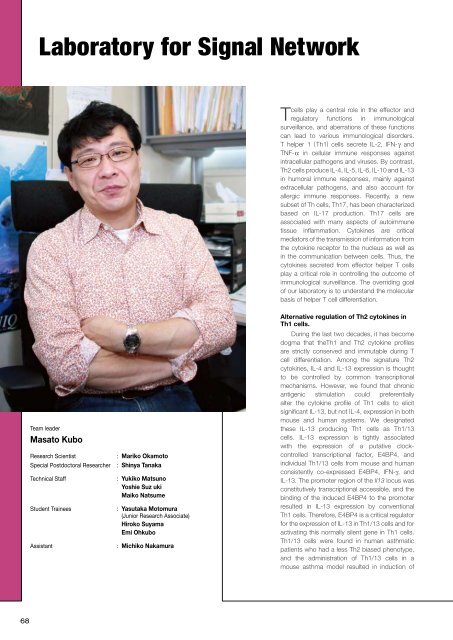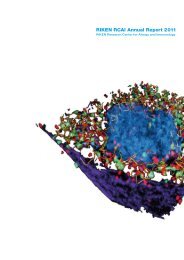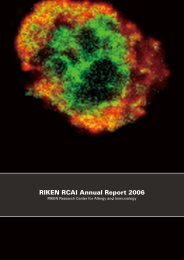in vivo
in vivo
in vivo
Create successful ePaper yourself
Turn your PDF publications into a flip-book with our unique Google optimized e-Paper software.
Laboratory for Signal Network<br />
cells play a central role <strong>in</strong> the effector and<br />
T regulatory functions <strong>in</strong> immunologi cal<br />
surveillance, and aberrations of these functions<br />
can lead to various immunological disorders.<br />
T helper 1 (Th1) cells secrete IL-2, IFN-γ and<br />
TNF-α <strong>in</strong> cellular immune responses aga<strong>in</strong>st<br />
<strong>in</strong>tracellular pathogens and viruses. By contrast,<br />
Th2 cells produce IL-4, IL-5, IL-6, IL-10 and IL-13<br />
<strong>in</strong> humoral immune responses, ma<strong>in</strong>ly aga<strong>in</strong>st<br />
extracellular pathogens, and also account for<br />
allergic immune responses. Recently, a new<br />
subset of Th cells, Th17, has been characterized<br />
based on IL-17 production. Th17 cells are<br />
associated with many aspects of autoimmune<br />
tissue <strong>in</strong>flammation. Cytok<strong>in</strong>es are critical<br />
mediators of the transmission of <strong>in</strong>formation from<br />
the cytok<strong>in</strong>e recep tor to the nucleus as well as<br />
<strong>in</strong> the communication between cells. Thus, the<br />
cytok<strong>in</strong>es secreted from effector helper T cells<br />
play a critical role <strong>in</strong> controll<strong>in</strong>g the outcome of<br />
immunologi cal surveillance. The overrid<strong>in</strong>g goal<br />
of our laboratory is to understand the molecular<br />
basis of helper T cell differentiation.<br />
Alternative regulation of Th2 cytok<strong>in</strong>es <strong>in</strong><br />
Th1 cells.<br />
Team leader<br />
Masato Kubo<br />
Research Scientist<br />
Special Postdoctoral Researcher<br />
Technical Staff<br />
Student Tra<strong>in</strong>ees<br />
Assistant<br />
: Mariko Okamoto<br />
: Sh<strong>in</strong>ya Tanaka<br />
: Yukiko Matsuno<br />
Yoshie Suz uki<br />
Maiko Natsume<br />
: Yasutaka Motomura<br />
(Junior Research Associate)<br />
Hiroko Suyama<br />
Emi Ohkubo<br />
: Michiko Nakamura<br />
Dur<strong>in</strong>g the last two decades, it has become<br />
dogma that theTh1 and Th2 cytok<strong>in</strong>e profiles<br />
are strictly conserved and immutable dur<strong>in</strong>g T<br />
cell differentiation. Among the signature Th2<br />
cytok<strong>in</strong>es, IL-4 and IL-13 expression is thought<br />
to be controlled by common transcriptional<br />
mechanisms. However, we found that chronic<br />
antigenic stimulation could preferentially<br />
alter the cytok<strong>in</strong>e profile of Th1 cells to elicit<br />
significant IL-13, but not IL-4, expression <strong>in</strong> both<br />
mouse and human systems. We designated<br />
these IL-13 produc<strong>in</strong>g Th1 cells as Th1/13<br />
cells. IL-13 expression is tightly associated<br />
with the expression of a putative clockcontrolled<br />
transcriptional factor, E4BP4, and<br />
<strong>in</strong>dividual Th1/13 cells from mouse and human<br />
consistently co-expressed E4BP4, IFN-γ, and<br />
IL-13. The promoter region of the Il13 locus was<br />
constitutively transcriptional accessible, and the<br />
b<strong>in</strong>d<strong>in</strong>g of the <strong>in</strong>duced E4BP4 to the promoter<br />
resulted <strong>in</strong> IL-13 expression by conventional<br />
Th1 cells. Therefore, E4BP4 is a critical regulator<br />
for the expression of IL-13 <strong>in</strong> Th1/13 cells and for<br />
activat<strong>in</strong>g this normally silent gene <strong>in</strong> Th1 cells.<br />
Th1/13 cells were found <strong>in</strong> human asthmatic<br />
patients who had a less Th2 biased phenotype,<br />
and the adm<strong>in</strong>istration of Th1/13 cells <strong>in</strong> a<br />
mouse asthma model resulted <strong>in</strong> <strong>in</strong>duction of<br />
68





